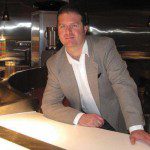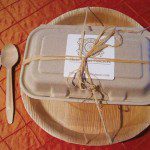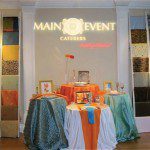Catering to Mother Earth
By • November 3, 2011 0 1588

Swiss born and raised, Joêl Thévoz hit Washington in the mid-’80s with a business degree and a briefcase full of fresh ideas. Coming off la vida loca in Costa Rica and Mexico, where his on-the-fly dinners were highly praised by friends and neighbors, he had decided to settle down to a serious culinary career.
With his wife and partner, Nancy Goodman, they launched Main Event Caterers in 1995 on K Street in Georgetown. Ten years later they were to bring their ever-expanding operations into Arlington, VA, where their stunning cuisine and lavish events garner rave reviews and an ever-increasing upscale clientele.
They ran their company like every other top-tier caterer until three years ago. Motivated by Al Gore’s groundbreaking film, “An Inconvenient Truth,” they had an epiphany and took their successful company to higher level — one with a conscience — where green is the new black. It would hail a new dynamic for Main Event Catering and reflect their growing ecological awareness.
Now in the vanguard of a new aesthetic where style meets substance, this sophisticated caterer is a leader in the green revolution, as they continue to be recognized with a growing list of local and national green business awards that reflect their commitment and the caliber of their cuisine. To add to their accomplishments, this year they won the coveted “Caterer of the Year” award from industry giant Catering Magazine.
I spoke with the passionately eco-knowledgeable Thévoz and toured the 20,000 square-foot facility with its gleaming stainless steel demonstration kitchen-in-the-round, 25-foot floor-to-ceiling wine wall and extensive culinary library, featuring a precious archive of leather-bound Gourmet magazines dating from 1946.
How long have you been on the green bandwagon?
We started out being aware of our impact in this world about three years ago. The green movement was just getting started here and, for us, that set the pitchfork in the ground in terms of thinking about what we do and how we do it.
There was one very impactful moment for us. It was a day when we were winding up after an event that used disposables. And at the time I was very proud of using the best quality plastics. I took a look at our truckload worth of waste and plastic garbage from this one event and I was literally sick to my stomach. I thought this stuff is going to last forever. What can we do better?
What did you do to change your company’s way of doing business?
That moment set the tone for a period of discovery. We wondered, “Can we find products that are biodegradable?” It was right about the time when cups made from cornstarch by-product became available. I had seen them used in an airport in England and brought some back with me.
But it was a real challenge to find these things in the U.S. We started digging around and discovered they were making plates from dead palm fronds in India. They are sandwich-pressed using steam into these flat shapes with a bit of curvature to make a plate. Then they are hand-scissored to size.
Finally, we could eliminate all plastics from our catered service, and now we only use biodegradable palm plates, balsa wood cutlery, washable glassware and other biodegradable products for our events using disposables. Also, we use purified water in jugs in place of mini plastic bottles.
How do you recycle?
We bring large recycling cans on site, and all our staff is trained to separate out recyclables like paper, cardboard, tin, glass and plastic. Then it gets brought back here where we take it to the recycling center. It does add to the workload of an event, but we still do it effectively.
We also decided to add solar concentrators to the roof over the individual offices to bring in light and we are now replacing all our metal halide lights with T5 lights that use a minimal amount of electricity and are motion-sensitive. This way they shut off when someone leaves the room. The floors here are bamboo, the ice machines use filtered water and we clean and press all our linens to lessen our carbon footprint.
To be carbon-neutral we buy carbon credits to offset all the energy that is used, as with our trucks going to and from events. Also, we calculated the approximate employee commute for the whole team and buy carbon credits to offset all those greenhouse gases, so that now we are 100 percent carbon-neutral. We’ve been doing that for three years.
What other ways have you found to save energy?
For one thing, we compost our food matter to make high-quality soil that we distribute to our community, and we collect and store all of our used cooking oil, that we donate to a local biodiesel cooperative.
Also, we wanted to subsidize wind power. So we purchase an equivalent amount of electricity from a wind farm. And though it is off-site, it gives us the advantage of being technically wind-powered. It tells the energy company that we are serious and we want to spend our money on clean energy … because unless you prove with dollars that there is a desire to purchase alternative energy, they won’t listen. We’ve seen how it creates momentum when a lot of companies get involved.
Have you figured out how much more it costs to do business in this way?
We have a general idea, and of course the start-up costs were quite high, but it is far outweighed by the amount of business we receive from clients that are like-minded. Companies and individuals who like what we are doing eventually gravitate to us and we feel rewarded.
We live happy and it has paved the way to the next stages in our development. It’s given us the knowledge and the confidence and introduced us to organizations that have things to offer us that are above and beyond anything else that we’ve done so far.
What are some of the newest technologies that you’ll be using?
Lately we find we are becoming a sort of incubator for green solutions.
Not long ago we had a visit from a gentleman based in Florida and began to talk about using geothermal. I mentioned how our dishwasher pushes out gallons of 180 degree water and it just goes down the drain. He told us we could divert it and harness it. Ultimately his company designed a product for us using heat exchange and we’ll be testing it here. The plan is to have it up and running in a few weeks.
In a nutshell, we will be running “grey” water alongside the city water pipes to super-heat municipal water. The fresh and “grey” water don’t mix together. There are membranes between the two of them. But in this way we can take the 65 degree water from the county and introduce it through our ”grey” water cisterns before it goes into the pipes. Eventually it will raise the temperature of our instant hot water for our washing machines two-fold to 130-160 degrees. It will save us a lot on gas usage.
Is that a cost to the city?
No, we handle it all from here. We’ll build a tank and the city water will go right through it.
We’re also looking at placing these huge cisterns beside our buildings to gather and harness the rainwater from our roofs. Imagine! They can collect up to 40,000 gallons per month of water. What we want to do is use those tanks for latent energy.
We subscribe to a train of thought that the future of this world is based upon communities building vertical farming. We have these flat roofs here and we are in the process of designing a rooftop garden with greenhouses to grow all our own vegetables and herbs. We have at least 6,000 square feet of roof space. We want to prove that it can be done and share the plots with the community.
The greenhouse will be hydroponic and aeroponic, which is a system NASA developed that uses an oscillator that is introduced into a water tank. You create a certain vibration and it renders the water into a mist. You can then push that vapor, with pressure, into a system of canals or closed chambers in which the roots of your vegetables thrive without soil. Every intermittent three minutes the pipes are filled and then flushed. It works like a rainforest. The plants grow at 2-3 times the speed.
What about the “terroir” — the taste imparted to the vegetables from the soil and its minerals? Won’t that be missed?
We can introduce that into the water by making a slurry from our compost and extracting the minerals out in liquid form to fortify the water, or we can buy organic feed to add to it.
Our last initiative will be to crush our glass and smelt it in kilns and create recycled glass slabs to use for platters and bowls. We are interested in inviting others, even our competitors, to see how we are doing this. We look to inspire others.
What do you see for the future of catering?
I foresee in the next few decades that we’ll move towards a more vegan and a more raw diet and a more healthful nutritious diet. So we’re making a small push to increase our vegetarian options and training ourselves to be better at cooking those options for our clients that want them, and for the future of our planet too.
For questions or comments contact jordan@whiskandquill.com.
- Main Event Caterers’ Joel Thevoz | Jordan Wright




